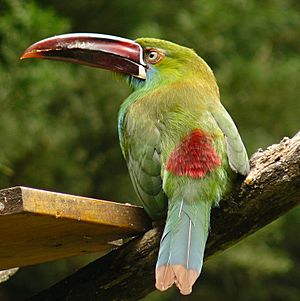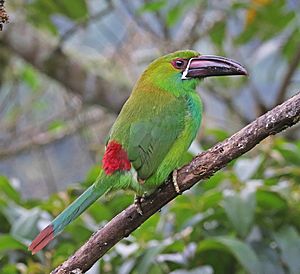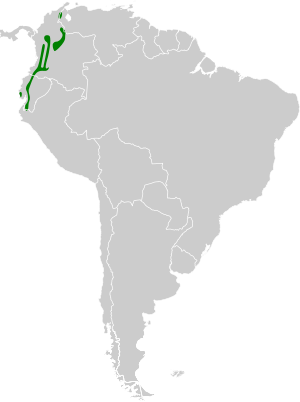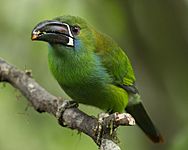Crimson-rumped toucanet facts for kids
Quick facts for kids Crimson-rumped toucanet |
|
|---|---|
 |
|
| Coming for bananas in the West Andes of Colombia | |
 |
|
| A. h. sexnotatus in northwestern Ecuador | |
| Conservation status | |
| Scientific classification | |
| Genus: |
Aulacorhynchus
|
| Species: |
haematopygus
|
| Subspecies | |
|
See text |
|
 |
|
| Synonyms | |
|
|
The crimson-rumped toucanet is a colorful bird from the toucan family, known for its bright feathers. Its scientific name is Aulacorhynchus haematopygus. You can find these interesting birds in the countries of Colombia, Ecuador, and Venezuela.
Contents
About the Crimson-Rumped Toucanet
What's in a Name?
The crimson-rumped toucanet was first described a long time ago. Scientists originally placed it in a different group of birds called Pteroglossus. Today, we know there are two main types, or subspecies, of this toucanet. One is called A. h. haematopygus, and the other is A. h. sexnotatus.
Appearance of the Toucanet
How Big Are They?
Crimson-rumped toucanets are about 40 to 45 centimeters (16 to 18 inches) long. The A. h. haematopygus subspecies usually weighs between 200 and 232 grams (7.1 to 8.2 ounces). The A. h. sexnotatus subspecies is a bit lighter, weighing 141 to 200 grams (5.0 to 7.1 ounces).
What Do They Look Like?
Both male and female toucanets have similar bright green feathers. Their upper back and the back of their neck often have a shiny gold color. A special feature is their bright red rump, which gives them their name! Their tail feathers also have chestnut-colored tips.
Around their dark eyes, they have bare, orange-brown skin. The A. h. haematopygus type has blue feathers above and below its eyes and on the sides of its chest. The A. h. sexnotatus type has less blue in these areas.
Their bill (beak) is brownish-red and black. It has a clear white line at its base. The A. h. haematopygus subspecies has more black on its bill than A. h. sexnotatus. Female toucanets have a shorter bill than males. Young toucanets are not as brightly colored. Their rump is more orangey, and their bill is mostly reddish without the white line.
Where Toucanets Live
Their Home Range
The A. h. haematopygus subspecies lives in western Venezuela. It also lives in northern and central Colombia, on both sides of the Andes mountains. It might even be found in northern Ecuador. The A. h. sexnotatus subspecies lives on the western side of Colombia's Western Andes. It stretches south into Ecuador's Loja Province.
Preferred Habitats
These toucanets mostly live in evergreen forests. You can find them from lowlands up to mountain areas. They also like semi-open places, such as forest edges. Sometimes, they are seen in forests that are growing back. They might even visit isolated fruit trees in pastures and gardens. They usually live at elevations between 300 and 2,200 meters (980 to 7,200 feet). Sometimes, they can be found as high as 2,750 meters (9,020 feet).
Toucanet Behavior
How They Move Around
Crimson-rumped toucanets seem to stay in one place. Scientists have not seen them move to different areas during the year.
What They Eat
These toucanets look for food at all levels of the forest. They might search alone, in pairs, or in small groups. Their main food is fruit. They probably also eat insects and bird eggs.
Raising a Family
The main time for crimson-rumped toucanets to breed is from January to May. In some parts of Colombia and Ecuador, it can start as early as November. When a pair forms, both the male and female sing and call to each other. They chase each other and even feed each other. They also preen each other's feathers, which is called allopreening.
They are thought to build their nests in old woodpecker holes. When kept in special care, they can lay up to four eggs. The eggs hatch in about 16 to 17 days. The young birds are ready to fly about four to five weeks after they hatch.
Sounds They Make
The song of the crimson-rumped toucanet is a series of rough, barking notes. It sounds like "daakk" or "gggruk." Both males and females sing, sometimes together. They also make soft, long notes and rattling sounds. When a pair interacts, they make loud wing sounds.
Conservation Status
Are They Safe?
The IUCN (International Union for Conservation of Nature) has looked at the crimson-rumped toucanet. They have decided it is a species of "Least Concern." This means it is not currently in danger of disappearing.
The bird lives in a large area. Even though we don't know the exact number of birds, their population seems to be stable. No immediate threats have been found. They are common in Colombia and fairly common in Ecuador. They also live in protected areas in both countries. These toucanets can adapt well to different environments. They even use forests that are growing back. They also breed successfully when cared for by humans.
Gallery
-
At the San Diego Zoo
See also
 In Spanish: Tucanete culirrojo para niños
In Spanish: Tucanete culirrojo para niños




